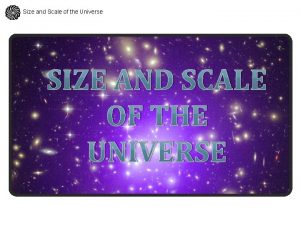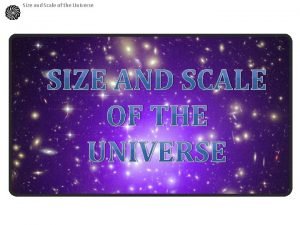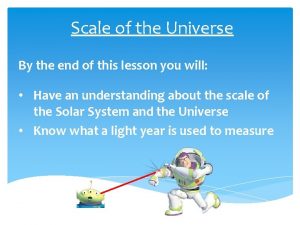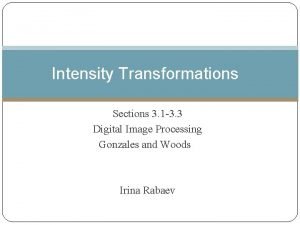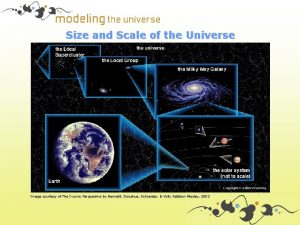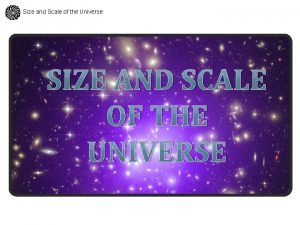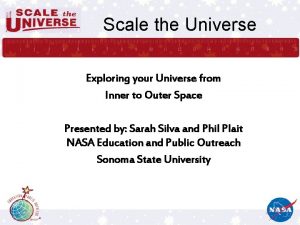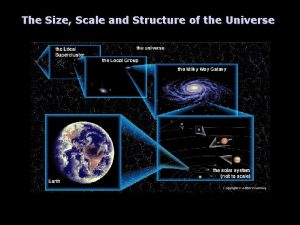Size and Scale of the Universe Image courtesy
















- Slides: 16

Size and Scale of the Universe Image courtesy of The Cosmic Perspective by Bennett, Donahue, Schneider, & Voit; Addison Wesley, 2002

Earth • Planet where we all live • Comprised primarily of rock • Spherical in shape • 12, 700 km in diameter • It would take 17 days to circumnavigate the globe driving a car at 100 km/hr • At the speed of light, it would take 0. 13 seconds to go all the way around Earth.

Sun • Star that Earth orbits • Composed primarily of hydrogen and helium gas • Uses nuclear fusion in its core to generate heat and light to allow itself to resist the crushing weight of its own mass • Spherical in shape • 1. 39 Million km in diameter

Earth & Sun • The Sun’s diameter is 109 times greater than that of Earth • Over 1 million Earths would fit inside the Sun’s volume • Earth orbits the Sun at an average distance of 150 million kilometers. This distance is called an Astronomical Unit (AU) • It would take 11, 780 Earths lined up side to bridge the 1 AU between Earth and Sun.

The Solar System • 8. 5 planets, thousands and thousands of planetoids and asteroids, billions of comets and meteoroids • Mostly distributed in a disk about the Sun • Sun blows a constant wind of charged gas into interplanetary space, called the Solar Wind Boundary between Solar Wind and interstellar space at 100 AU from the Sun (200 AU diameter)

The Solar Neighborhood • The region of the Galaxy within about 32. 6 lightyears of the Sun (65 lightyears diameter) is considered its neighborhood. To Center of Galaxy • Here stars move generally with the Sun in its orbit around the center of the Galaxy • This region is inside a large bubble of hot interstellar gas called the Local Bubble. Here the gas temperature is about 1 million degrees Kelvin and the density is 1000 times less than average interstellar space. The image is 390 light-years across. Direction of Galactic Rotation

The Milky Way Galaxy is a giant disk of stars 160, 000 light-years across and 1, 000 light-years thick. The Sun is located at the edge of a spiral arm, 30, 000 light-years from the center It takes 250 Million years for the Sun to complete one orbit You Are Here There are over 100 Billion stars in the Milky Way The Spiral arms are only 5% more dense than average, and are the locations of new star formation

The Local Group • Contains 3 large spiral galaxies--Milky Way, Andromeda (M 31), and Triangulum (M 33)—plus a few dozen dwarf galaxies with elliptical or irregular shapes. • Gravitationally bound together—orbiting about a common center of mass • Ellipsoidal in shape • About 6. 5 million light-years in diameter

The Local Supercluster • A cluster of many groups and clusters of galaxies • Largest cluster is the Virgo cluster containing over a thousand galaxies. • Clusters and groups of galaxies are gravitationally bound together, however the clusters and groups spread away from each other as the Universe expands. • The Local Supercluster gets bigger with time • It has a flattened shape • The Local Group is on the edge of the majority of galaxies • The Local Supercluster is about 130 Million light-years across

1. 3 Billion light-years The Universe • Surveys of galaxies reveal a web-like or honeycomb structure to the Universe The plane of the Milky Way Galaxy obscures our view of what lies beyond. This creates the wedge-shaped gaps in all -sky galaxy surveys such as those shown here. • Great walls and filaments of matter surrounding voids containing no galaxies • Probably 100 Billion galaxies in the Universe

The Universe The observable Universe is 27 Billion light-years in diameter. Computer Simulation

There are two basic methods for measuring astronomical distances 1) The Standard Ruler • • • Use knowledge of physical and/or geometric properties of an object to relate an angular size with a physical size to determine distance. Ex: Parallax, Moving Clusters, Time Delays, Water MASERs Considered to be a direct or absolute measurement. R d d = R/Tan( ) R/

Trigonometric Parallax • Requires very precise measurements of stellar positions, and long baselines • Need telescopes with high resolution, and must observe over several years. • Hipparchos satellite measured distances to tens of thousands of stars within 1, 500 light-years of the Sun.

2) The Standard Candle • Use knowledge of physical and/or empirical properties of an object to determine its Luminosity, which yields distance via the Inverse Square Law of Light. • Ex: Cepheid Variables, Supernovae, TRGB, Tully-Fisher • Considered to be relative until tied to an absolute calibration. b = L/4 d 2

Cepheid Variable Stars There is a kind of giant star whose surface pulsates in and out with a regular period. That period of pulsation is related to the Luminosity of the star. LMC contains hundreds of known Cepheids all at the same distance. Which allows for robust determination of the Period Luminosity Relationship.

To measure cosmological distances a ladder of methods is used to reach further out into the Universe. Each “rung” in the ladder of distance measuring methods depends on the calibration of the methods “below. ”
 Universe size scale
Universe size scale Orbit venus
Orbit venus The scale of the universe interactive
The scale of the universe interactive Scale of the universe
Scale of the universe Expressions of courtesy
Expressions of courtesy Greetings farewells and courtesy expressions en español
Greetings farewells and courtesy expressions en español Power-law (gamma) transformations
Power-law (gamma) transformations Courtesy notice
Courtesy notice Courtesy award
Courtesy award Clarity and completeness
Clarity and completeness Courtesy clarity conciseness concreteness completeness
Courtesy clarity conciseness concreteness completeness Courtesy is a positive trait
Courtesy is a positive trait Commerative speech
Commerative speech Respect attitude
Respect attitude Clarity in communication
Clarity in communication Service courtesy
Service courtesy Military courtesy definition
Military courtesy definition
